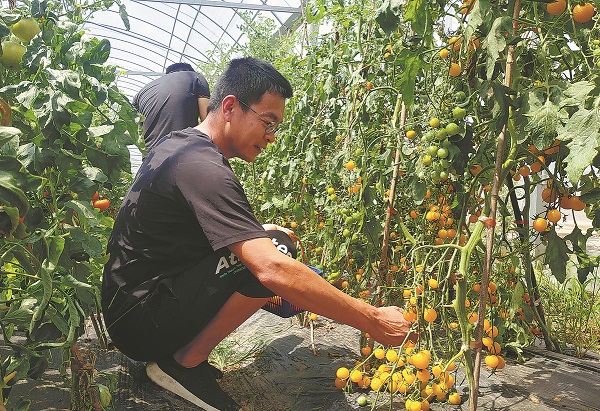Development stretches from 'mountains to sea'
Wang Weibo examines cherry tomatoes in a greenhouse in Longyou county of Quzhou, Zhejiang province. XU YOULEI/FOR CHINA DAILY
Geographically diverse Zhejiang province achieves balanced growth, common prosperity
Editor's note: In this series, China Daily looks at some of the areas in which major progress has been made in the 10 years since the 18th National Congress of the Communist Party of China was held in November 2012.
Inside a greenhouse base in Tuanshi, a village in Longyou county in East China's Zhejiang province, 39-year-old Wang Weibo carefully examined the growing conditions of different varieties of cherry tomatoes. They would soon be ripe and ready for picking.
It was in early July, and the temperature in the greenhouse had already reached over 40 C. But for Wang, the heat seemed to have made him even more enthusiastic.
"The taste of our tomatoes is among the best in the industry," Wang said proudly.
The base's tomatoes are highly popular. They usually sell out soon after they're harvested.
According to the production base, the yield of Wang's tomatoes per hectare can reach 30,000 kilograms. Planted for two seasons each year, the tomatoes grown in the base, which covers an area of 2.87 hectares, can generate annual income of 600,000 yuan ($84,215) per hectare.
Half of that is profit, Wang said.
The production base has also created 20 jobs for local farmers, who can each earn roughly 3,000 yuan per month.
Moreover, the popularity of the base's cherry tomatoes has spurred the development of agriculture-based entertainment in Tuanshi village, as tourists throng there to pick tomatoes and enjoy the idyllic scenery.
Since 2021, the collective economy of the village has more than tripled, growing from less than 100,000 yuan to more than 300,000 yuan, and the per capita annual income of villagers has increased from 12,000 yuan to 17,000 yuan.
-
Xixi Wetland invites visitors to Huazhao Festival
March 25, 2025
-
Hangzhou sets standard for concert hosting
March 19, 2025
-
What is making Hangzhou the new tech powerhouse of China?
March 10, 2025
-
Inside Hangzhou: China's high-tech dream factory
March 12, 2025




